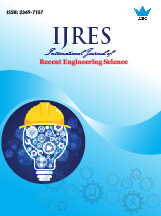Mechanical Engineering in Ancient Egypt, Part XVIII: Ladies Headdress in the New Kingdom
 |
International Journal of Recent Engineering Science (IJRES) |  |
| © 2016 by IJRES Journal | ||
| Volume-3 Issue-3 |
||
| Year of Publication : 2016 | ||
| Authors : Galal Ali Hassaan |
||
| DOI : 10.14445/23497157/IJRES-V3I3P103 |
How to Cite?
Galal Ali Hassaan "Mechanical Engineering in Ancient Egypt, Part XVIII: Ladies Headdress in the New Kingdom," International Journal of Recent Engineering Science, vol. 3, no. 3, pp. 12-21, 2016. Crossref, https://doi.org/10.14445/23497157/IJRES-V3I3P103
Abstract
The objective of this paper is to investigate the development of mechanical engineering in ancient Egypt through ladies headdress industry in the New Kingdom. This study covers the design and manufacturing of ladies headdresses in the 18th and 19th dynasty showing the sophistication and uniqueness of some of the designs illustrating their decoration.
Keywords
Mechanical engineering history, ladies headdress industry in ancient Egypt, New Kingdom , dynasty 18 dynasty 19.
Reference
[1] G. A. Hassaan, Mechanical engineering in ancient Egypt, Part II: Jewellery industry (Pectorals), International Journal of Recent Engineering, vol.19, January 2016, 25-32.
[2] G. A. Hassaan, Mechanical engineering in ancient Egypt, Part III: Jewellery industry (Necklaces), International Journal of Engineering and Techniques, vol.2, issue 1, 2016, 59-67.
[3] G. A. Hassaan, Mechanical engineering in ancient Egypt, Part IV: Jewellery industry (Bracelets), International Journal of Science and Engineering, vol.2, issue 2, 2016, 16-30.
[4] G. A. Hassaan, Mechanical engineering in ancient Egypt, Part X: Pottery industry (Middle to New Kingdoms), International Journal of Science and Engineering, vol.2, issue 4, 2016, 7-18.
[5] G. A. Hassaan, Mechanical engineering in ancient Egypt, Part XIV: Stone vessels (Middle Kingdom to Third Intermediate Period), International Journal of Engineering and Techniques, 2016, Accepted for Publication.
[6] G. A. Hassaan, Mechanical engineering in ancient Egypt, Part XV: Faience vessels (New Kingdom to Third Intermediate Period), International Journal of Science and Engineering, vol.2, issue 5, 2016, Accepted for Publication.
[7] E. W. Watt and E. A. Watts, The art of ancient Egypt, a resource for educators, Metropolitan Museum of Art, 1998.
[8] K. Hilliard, Images of a genedard Kingship, visual representations of Hatshepsut and her influence on images of Nefertiti, Master of Arts Thesis, University of North Texas, August 2006.
[9] D. Silverma, Amarna ancient Egypt’s place in the sun,, Pinn Museum, 2006.
[10] A. Olivier, Social status of elite women of the New Kingdom of ancient Egypt: A comparison of artistic features, Master of Arts Thesis, University of South Africa, June 2008.
[11] M. Jansen, The iconography of humiliation: The depiction and treatment of bound foreigners in New Kingdom Egypt,, Ph.D. Thesis , The University of Memphis, Tennessee, USA, May 2013.
[12] D. Laboury, How and why did Hatshepsut invent the image of her royal power ?, in the rein of Hatshepsut, Edited by M. Galal, B. Bryan and P. Dorman, Occasional Proceedings of the Theban Workshop, The Oriental Institute of the University of Chicago, Chicago, USA, 2014.
[13] G. Robins, Nefertiti pours a drink for Akhenaten in the tomb of her steward Merira, ARCE 66th Annual Meeting, 24-26 April, TX, USA, 2015.
[14] A. Hammett, The clay balls of ancient Egypt: a sumbolic defence against Apophis, International Conference on Ancient Egyptian Manifestation of Luminal Entities , Swansea, Swansea University and Egypt Centre, Wales, UK, 21-24 March 2016, p.6.
[15] A. Getz, Wooden statue of Queen Ahmose-Nefertari, www.pinterest.com/pin/232850243207658086/
[16] O. Retro, Cedarwood coeffin of Queen Ahmose-Meritamun www.pinterest.com/ pin/211528513722603642/
[17] Egyptopia, Sarcophagus of AhmoseMeritamun, www.egyptopia.com/sarcophogus+of+ahmose+Me ritamun+The+Egyptian+Museum_30_382_448_en. html.
[18] A. Olivier, p.146.
[19] M. Smidt, Lady in waiting, www.pinterest.com/pin/490259109416672738/
[20] A. Sparks, Egyptian coffin of Harmose, www.pintirest.com/pin/547398529681062575/
[21] K. Keough, Wig cover, dynasty 18 rein of Thutmose III, www.pinterest.com/pin/547398529681062575/
[22] H. McLean, Wig from one of the Thutmose minor wives grave, www.pinterest.com/pin/283867582736271467/
[23] G. Giorgio, A black granite statue of Isis, www.pinterest.com/pin/545076361122295331/
[24] D. Down and J. Ashton, The Pharaoh and the Sphinx, http://answersingenesis.org/archaeology/ancientegypt/the-pharaoh-and-the-sphinx/
[25] A. Preston, Statue of lady Mi standing, www.pinterest.com/pin/72850842998285/
[26] R. Williams, Nebsen, a scribe in the royal treasury, www.pinterest.com/pin/22736148116448282805/
[27] Wikipedia, Nebamun, http://en.wikipedia.org/wiki/Nebamun, 2016.
[28] L. Yamaoka, Wall scenes from the tomb of Nebamun and his wife Hatshepsut, www.pinterest.com/pin/31243791141808763/
[29] J. Pickett, Statue of lady Resi from the Madinet Gurob tomb of Amenemapt, www.pinterest.com/pin/381750505887001552/.
[30] G. Gootjes, Queen Tiye, Greet Royal Wife of Pharaoh Amenhotep III, www.pinterest.com/pin/3265110417143575/
[31] M. Mayotte, Merytaten, Great Royal Wife to Pharaoh Smenkhkare, www.pinterest.com/pin/263038434463429138/
[32] Wikipedia, Kiya, www..http://en.wikipedia.org/wiki/Kiya, 2016.
[33] N. Bulle, Merit, 18th dynasty, www.pinterest.com/pin/411023903469522065/
[34] L. Wennberg, The wife of Nakhtmin, www.pinterest.com/pin/46443439879308582/
[35] Wikipedia, Tuya – Queen, http://wikipedia.org/wiki/Tuya_queen , 2016.
[36] K. Harper, Pharaoh Seti I and Hathor, www.pinterest.com/pin/386676317978422175/
[37] Alamy, Mother, tomb of Userhat, www.alamy.com/stock-photo-mother-tomb-ofuserhat-1313-1292-bc-new-kingdom-reign-of-setii-thebes-26985918.html
[38] Metropolitan Museum of Art, Yuny and his wife Renenutet, www.metmuseum.org/art/collection/search/544740
[39] S. Plessis, Nefertiti Karnak Temple Complex, www.pinterest.com/pin/528539706241495543/
[40] D. Elhard, Colossal Meritamen statue, www.pinterest.com/pin/186336503307913799/
[41] British Museum, Coffin, www.britishmuseum.org/collection.online/collectio n_object_details/collection_image_gallery.aspx?pa rtid=1&assetid=410874001&objectid=158614.
